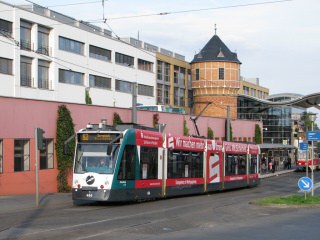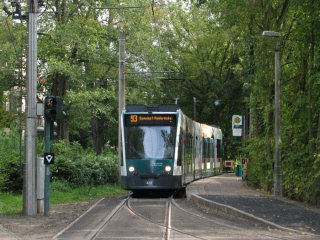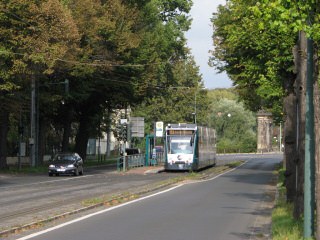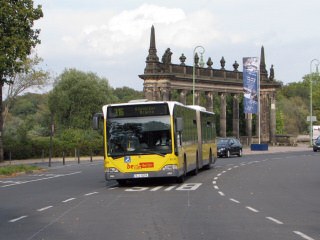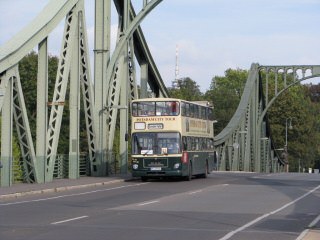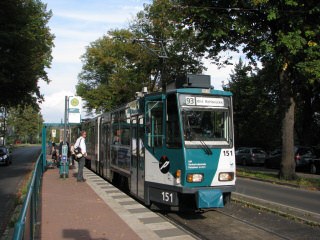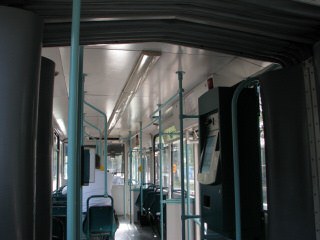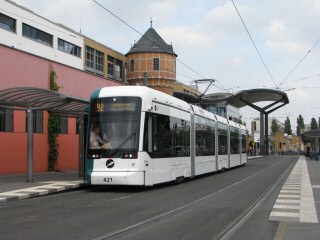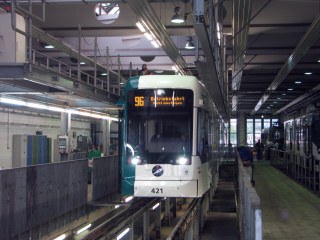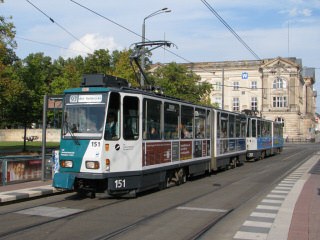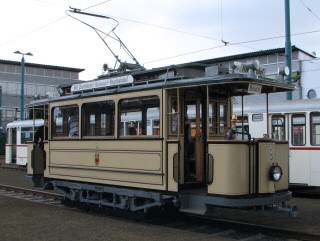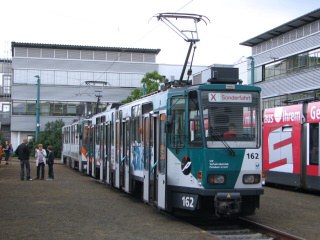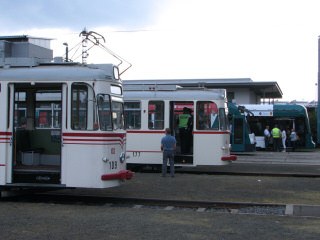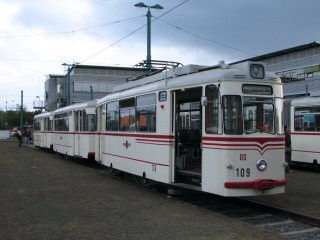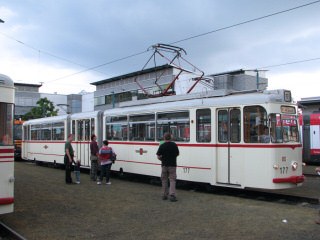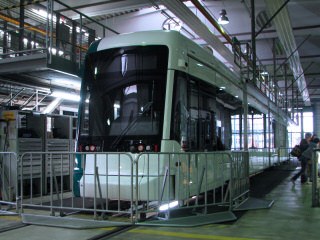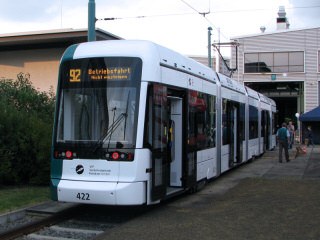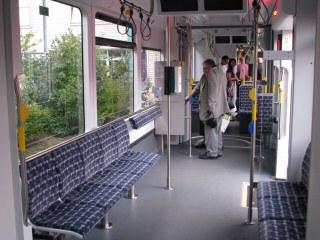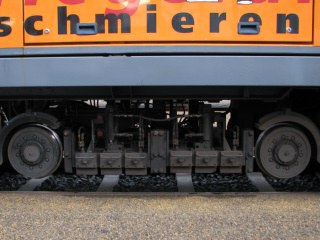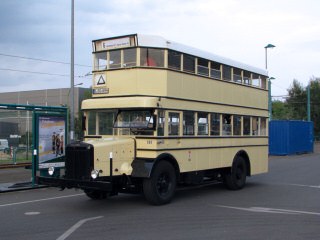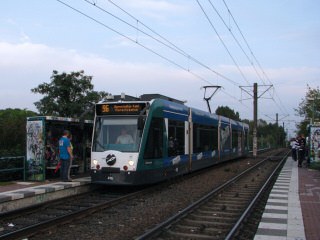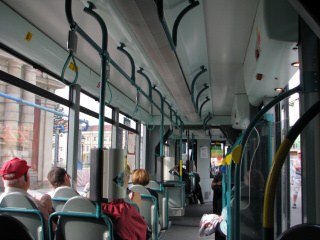budapest
other hungarian
close-up
lost rails
other countries
Potsdam: old trams, new trams
Hier geht's zur deutschsprachigen Version / Kattints ide a magyar változathoz
I went to Potsdam near Berlin on September 17, 2011 to see the public unveiling of their new tram, the Stadler Variobahn. Well, at least partially, because I also wanted to get to know the city better as a tourist and as someone who's interested in how these vicinities looked like during the existence of the Berlin Wall. In this letter goal I succeeded. In the first one, however...
But let's not jump so forth in time! I arrived around noon, and waited for a while in front of the main railway station to catch the prototype of the CKD Tatra KT4D, seen to the left. Of course, I also took a few photos of Combinos (right).
Then I headed to Glienicker Brücke - the bridge that once was nick-named "Bridge of the Spies". I did this with the tram, which interestingly reverses in a triangle (left) instead of a reversing loop. The real terminus is about 200 meters away from this triangle, and there are two tracks leading to that platform, so the whole facility is really a strange one!
Of course it must have been much stranger when the bridge, located about another 200 meters behind the terminus, was the closed and heavily guarded border between East-Germany (GDR) and West-Berlin (more precisely the american sector). Buses riding over the bridge like the Berlin one to the left and the Potsdam sightseeing one to the right were unimaginable back then.
And now it's time for a
video! Unfortunately the headways were rather long, so at some places I
could either take a photo or make a video, but not both (unless I wanted
to stand there for eternity). Here's a breakdown of what we see:
0:04- A Combino arriving
to the main wailway station (Hauptbahnhof)
0:15- The same place
a few hours later, with a Tatra KT4D double-set
0:27- Riding the tram
through Potsdam's old city center (which I find very nice)
0:42- Scenes of a ride
with a KT4D heading back to the city from Glienecker Brücke, via
the noble Berliner Strasse
1:08- The nice bend at Puschkinallee
1:18- At the turnout
for the tram depot
1:28- A bit of Combino
from the inside
1:47- The quiet terminal
loop at Marie-Juhacz-Strasse, located aside of a suburban housing
area built in GDR times
Two photos for Tatra fans. As for myself, I'm not a huge fan of Tatra trams in general, but I quite like the KT4!
And here's the main course on the day's menu - one which I didn't have luck with! I wanted to take pictures/videos on its first rounds (like the very first one, caught in front of the main railway station, to the left), and ride it later. I chose a favorable departure from the official schedule booklet published on the internet, but then I suddely saw the tram being where it shouldn't be - heading to east. What the heck, did I missed something? After waiting thirty minutes or its return it was clear that there was something wrong. I went to the depot, where I could see the vehicle moving... back into the repair halls (to the right). It didn't got back to circulation that day, so I missed the opportunity to ride it :-/
A video summarizing the
introduction of the Potsdam Variobahn:
0:04- Arriving to the main station (Hauptbahnhof)
for the first time with passengers
0:34- In the bend at Puschkinallee
0:46- Hey, what's this,
this vehicle shouldn't be here at this time of the day!
0:54- Moving inside the
depot - so that's where it went...
1:10- No more rides today
:(
To make good for the missed photo opportunities, here's another Variobahn in Potsdam, in 2005. It was a prototype belonging to Duisburg, built by ADtranz in 1996. Stadler leased this vehicle to advertise the type, which was taken over to their portfolio around that time. It seems they succeeded with this stunt - but to date this is the only Variobahn I have ridden in Potsdam :)
To the left: a KT4D double-set at Platz der Einheit. To the right: after realizing there's no sense in waiting for the Variobahn, I went to see the tram depot which opened its doors to the public on that day. The real star there I think was this freshly rebuilt Lindner four-wheeler from 1907.
Unfortunately the lights got so bad by then, that taking photos became a challange. Still, the display was a fascinating one! To the left: a double-set of Tatras, as seen in daily operation. To the right: a row of four-wheelers and four-wheelers converted into articulated trams. In the front: a Gotha T2-64, behind it a G4-65 - a "two rooms and a bath" type. Behind it, a Combino and a Variobahn, that are - being multi-articulated vehicles with short wheeled sections with longer sections suspended between them - basically built on the same principle ;)
Two more pictures of the Gothas: to the left the T2-64 with two matching trailers, and to the right the G4-65.
Two Variobahns: one in the repair hall yet without a fleet number, and another one on static display.
Here are two photos of the interior of the latter. To the left, a short section with the running gear, with "compartment seating" over the wheels, and to the right: a suspended section with longitudal benches. A strange interior layout, I would say.
The railgrinder of the system, with a closer look at the grinding apparatus to the right.
Two kinds of rubber-tyred vehicles: works cars to the left (some of them with small steel wheels to operate on rails), and a double-decker oldtimer from 1934 to the right.
After the visit at the depot, I went to explore some corners of the tram network which I didn't see before. On these pictures: a Combino from the outside, and another one from the inside.
Underway I recorded this: a Combino "booting up" after a halt in a stop. I don't know why the vehicle was "switched off", because I only noticed when it started up afterwards, but it was fun to see (and hear) the systems of the vehicle coming to life: the ticket validators, the primary passenger information displays, the lighting, the air conditioning, the monitors... and then we were on the way to the next stop.
Back to the top Back to the main page

